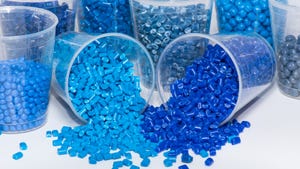The automotive market’s recent numbers are grim enough to forget that armies of engineers at all the OEMs, as well as at their suppliers, wake up every morning not thinking about their respective companies’ balance sheets, but about how to make a better car.
November 24, 2008
The automotive market’s recent numbers are grim enough to forget that armies of engineers at all the OEMs, as well as at their suppliers, wake up every morning not thinking about their respective companies’ balance sheets, but about how to make a better car.
Nowhere is this continual development better displayed than at the Society of Plastics Engineers (SPE; Brookfield, CT) Automotive Innovation Awards. Judging for the awards took place in October in Auburn Hills, MI, where the skyline is dominated by Chrysler’s world headquarters and its distinctive pentagram crown, and the news at the time was preoccupied with rumors of a potential Chrysler/General Motors merger.
Inergy fuel tank Moving beyond TI Automotive’s “ship-in-a-bottle” technology for fuel tanks, Inergy devised a new process, twin-sheet blowmolding, to create the fuel tank for the BMW 7 Series with automatic integration of interior components. |
Within the Ticona Application Development Center, which hosted judges from OEMs, suppliers, the consulting world, the trade media, including MPW, the focus was on innovation, and quite often, one number—35—as in 35 miles/gallon, the pending mileage target for CAFE (corporate average fuel economy).
Plastics is seen as a bridge towards better fuel economy, both in its inherent weight advantages over competitive materials like steel, and its ability to save weight and labor by offering integrated assembly.
New fuel tank, new process
Both those qualities were on display in the Grand Award winner, a twin-sheet blowmolded (TSBM) fuel system, which also won in the process/assembly/enabling category. The description is not a typo, with supplier Inergy Automotive Systems essentially creating a new process where a parison is split in the die head and each side blown onto a central core to combine the advantages of an extrusion blowmolded fuel system with the design flexibility of a half-shell process, with the still-hot halves joined together for a strong seal. The result is a fuel tank for the BMW 7 Series that meets PZEV emissions requirements, boosts tank capacity, lowers emissions, eliminates post-mold operations, and reduces system weight and cost. According to Inergy’s Dave Hill, who presented the system to the panel, the technology allows all the necessary components, like baffles, to be mounted within the tank automatically and without having to cut open the tank post production, which can affect its emissions capabilities during its useful life.Inergy was able to install a level sensor on the secondary side of this saddle tank without the usual access hole required to install components. This results not only in a cost savings, but in a permeation and weight savings as well. Inergy also was able to mount all of the venting components internally, eliminating the need for several holes in the surface of the tank as well as external welding.
Hill said the five- and six-layer tanks are produced in cycles that are only about two seconds longer than traditional methods, with total times around 100 seconds, depending on the tank. Among other benefits to TSBM, Hill cited greater wall thickness control, which lowers part weight; integrated baffles to reduce noise; and optimal positioning of the level-sensor gauge, venting valves, and fuel-delivery module, which all increase fuel capacity, and therefore, the car’s range.
Another blowmolded winner in the competition was the integrated rocker molding/running board for the Ford Escape, blowmolded by the ABC Group using Salflex Polymers’ 30% glass-filled PP. The part won the ‘Body Exterior’ category award.
Soft-touch IP without PUR or PVC
Runner up to the TSBM 7 Series fuel tank for the Grand Award was a specially formulated thermoplastic polyolefin (TPO)/thermoplastic elastomer (TPE) slush molded into an instrument panel (IP) skin, which won the materials category. The first TPO/TPE slush-molded IP manufactured in North America, the technology was applied by Inteva Products (ex. Delphi Interiors) for General Motors and the Saab 9-7X SUV. Inteva’s Tom Ellis said the patented technology, which has been licensed to compounder A. Schulman, can be molded on the same equipment as the vinyl and urethane it replaces, with equivalent or greater performance, 20% lower weight, and without VOC emissions or fogging. An additive is used to boost the high powder-packing density and increase flow, bringing the cryogenically ground material closer to PVC’s melt viscosity. Marketed under Invision SLX trade name, the system utilizes a proprietary powder flow material and is not fluorinated. Ductile at -30°C, Ellis said it exhibits better brittle failure than PVC.—[email protected]
2008 SPE Automotive Innovation Award Winners
Materials: Slush molded TPO/TPE instrument panel created by Inteva Products for GM’s Saab 9-7X SUV.
Environmental: Soy-foam automotive seat cushions for the Ford Mustang molded by Lear using soy-polyol-based foam.
Chassis/hardware/powertrain: Oil-pan module molded from DuPont glass-reinforced nylon 6/6 by G. Bruss GmbH for Daimler’s Mercedes C Class sedan.
Body interior: Integrated floor shifter/front console for the Ford Flex CUV molded by Automotive Component Holdings using Nova Chemical recycled styrene maleic anhydride and long-glass PP.
Body exterior: Integrated rocker molding/running board for the Ford Escape blowmolded by the ABC Group using Salflex Polymers’ 30% glass-filled PP.
Performance & customization: Dual-weave carbon-fiber composite hood assembly created by Plasan Carbon Composites for GM’s ZR1 Corvette.
Process/assembly/enabling technologies: Twin-sheet blowmolded fuel system for the BMW 7 Series sedan created by Inergy Automotive Systems using materials from LyondellBasell, Kuraray, Mitsui, and Ticona.
Safety: Polystyrene foam head-impact protection for the Ford Focus created by Grupo Antolin using Dow materials.
About the Author(s)
You May Also Like



